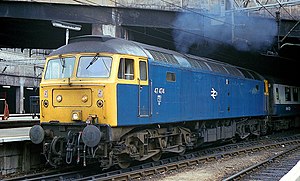
Back BR-Klasse 47 German British Rail Clase 47 Spanish Lokomotif British Rail Class 47 ID イギリス国鉄47形ディーゼル機関車 Japanese British Rail Class 47 Polish Clasa 47 (BR) Romanian British Rail Class 47 Russian British Rail Class 47 SIMPLE 英国铁路47型柴油机车 Chinese
| Brush Type 4 British Rail Class 47 | |||||||||||||||||||||||||||||||||
|---|---|---|---|---|---|---|---|---|---|---|---|---|---|---|---|---|---|---|---|---|---|---|---|---|---|---|---|---|---|---|---|---|---|
 A Class 47 at Birmingham New Street in 1987 | |||||||||||||||||||||||||||||||||
| |||||||||||||||||||||||||||||||||
| |||||||||||||||||||||||||||||||||
| |||||||||||||||||||||||||||||||||
| |||||||||||||||||||||||||||||||||
The British Rail Class 47 or Brush Type 4 is a class of diesel-electric locomotive that was developed in the 1960s by Brush Traction. A total of 512 Class 47s were built at Brush's Falcon Works in Loughborough and at British Railways' Crewe Works between 1962 and 1968, which made them the most numerous class of British mainline diesel locomotive.
They were fitted with the Sulzer 12LDA28C twin-bank twelve-cylinder unit producing 2,750 bhp (2,050 kW) – though this was later derated to 2,580 bhp (1,920 kW) to improve reliability – and have been used on both passenger and freight trains on Britain's railways for over 55 years. Despite the introduction of more modern types of traction, a significant number are still in use, both on the mainline and on heritage railways.
As of July 2024[update], 76 locomotives still exist as Class 47s, including 32 which have been preserved. 31 locomotives, including six which are preserved, retain mainline running certificates. A further 33 locomotives were converted to Class 57s between 1998 and 2004.